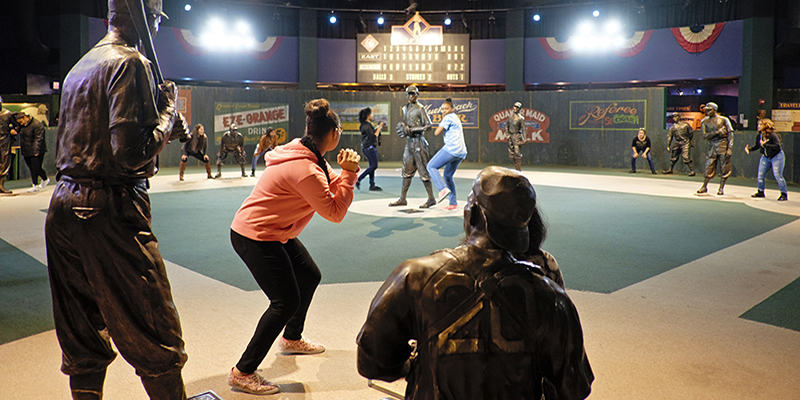
African-American Community in Kansas City
From art and music to food and sports, the contributions of Kansas City's African-American community are vital to the city's culture.
CULTURAL INSTITUTIONS

The African-American contribution to the fame and fortune of Kansas City is indelible. The storied Kansas City Monarchs won more championships than any sports team in Kansas City history. Explore the history of the Negro Leagues, and the men who made them famous, at the Negro Leagues Baseball Museum. One of those men was Kansas City icon Buck O’Neil, who became the face and voice of Negro Leagues Baseball when he appeared in Ken Burns’s award-winning documentary on the history of the game.

Talk to people around the world about Kansas City and they are likely to mention jazz. In its heyday, the likes of Count Basie, Jay “Hootie” McShann, Joe Turner, Mary Lou Williams, Benny Moten, Hot “Lips” Page and numerous others took the unique Kansas City sound to the world. Explore the story of jazz told thorough exhibits and interactive music stations at the American Jazz Museum. The museum is also home to one of Kansas City’s finest jazz clubs, The Blue Room.

As history tells us, legendary musicians of the area often engaged in nightlong jam sessions. That tradition continues today at the Mutual Musicians Foundation located in the historic 18th & Vine District.

One of the greats of jazz, Charlie “Bird” Parker, was born in Kansas City, Kan. He has been immortalized by world-renowned sculptor Robert Graham. The sculpture is located on the grounds of the American Jazz Museum. Parker’s gravesite is located at Lincoln Cemetery and a celebration is held each year on his birthday.
CUISINE

If jazz is the music of the soul, then barbecue is its sustenance. Kansas Citians are unabashedly protective of their reputation as the barbecue capital of the world and the 18th & Vine area was its incubator. A famous businessman of the time was the barbecue king, Henry Perry, whose establishment at 19th & Highland was a destination for all members of the Kansas City community, African-American and white alike.

Charlie Bryant learned the art of “cue” from Mr. Perry. He opened his first restaurant at 14th and Highland, while his brother Arthur, became an auto mechanic. When Charlie died, Arthur took over the restaurant, renaming it Arthur Bryant’s. The restaurant, now located at 18th & Brooklyn, has been called “the single best restaurant in the world” by New Yorker food critic (and Kansas City native) Calvin Trillin.

Just down the road at 19th & Vine, George Gates purchased a restaurant called Ol’ Kentuck’ in 1946. The restaurant would later be renamed Gates Bar-B-Q. Today there are six Gates locations and the award-winning restaurant is renowned for its signature “Hi, may I help you?” hospitality.
MORE SIGHTS

The 18th & Vine area resonates as the cultural center of the community. Once recognized as the African-American movie house for the area, the beautifully restored Gem Theater is now home to the “Jammin at the Gem” Jazz Masters concert series.
The Black Archives in the 18th & Vine area houses a wide collection of photographs, oral histories and correspondence documenting the history of the African-American community in the Midwest and in particular the Kansas City area. The Bruce R. Watkins Cultural Heritage Center at 3700 Blue Parkway is a prominent cultural resource providing gallery exhibitions, workshops, film series, musical and stage productions.
History

The first settlers of African descent were slaves brought into the area in the years before the Civil War. Following the abolition of slavery in 1865, black communities were founded along the East and West Bottoms and in the Westside area of the city. Many came to the area lured by the prospect of jobs with the railroad, stockyards and packinghouses that sprouted along the West Bottoms.
By the 1920s, the population of African-Americans in Kansas City had increased to more than 30,000, with an additional 14,000 in Wyandotte County. According to the 2010 census, one-eighth of the population of Kansas City was African-American, with 254,509 residents in the region.
As the African-American population grew, so too did its entrepreneurial presence in other parts of the city. The 18th & Vine area became a major focus and business hub for the community.
The area, later known for its nightclubs and jazz, was home to significant African-American businesses, including the Kansas City Call Newspaper, which published its first edition in 1919.
Multicultural heritage in KC
American Jazz Museum
Region: 18th and Vine Neighborhood, Downtown
Phone: (816) 474-8463
Visit WebsiteNegro Leagues Baseball Museum
Region: 18th and Vine Neighborhood, Downtown
Phone: (816) 221-1920
Visit WebsiteQuindaro Ruins Underground Railroad
Region: Kansas City, Kansas, Kansas
Phone: (913) 609-1587
Visit WebsiteBlack Archives of Mid-America, Inc.
Region: 18th and Vine Neighborhood, Downtown
Phone: (816) 221-1600
Visit Website



